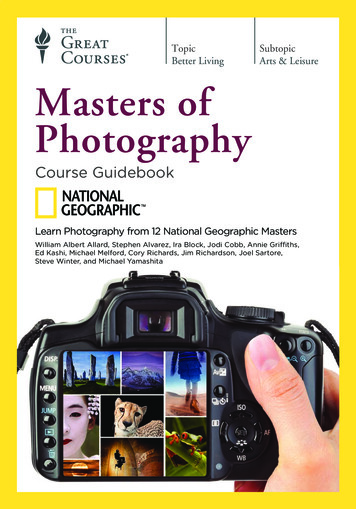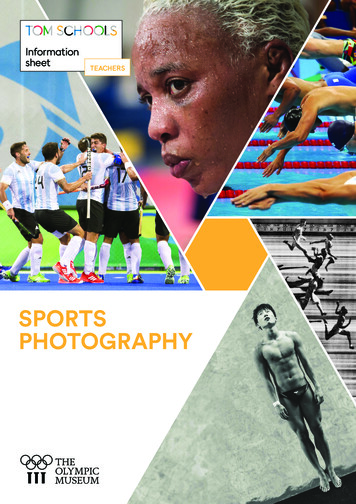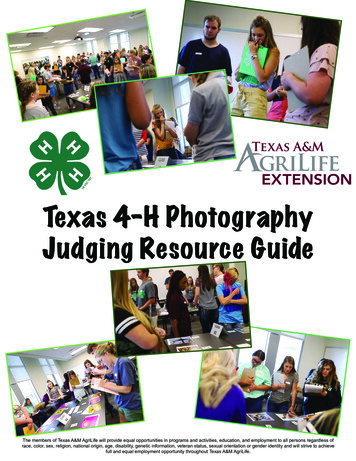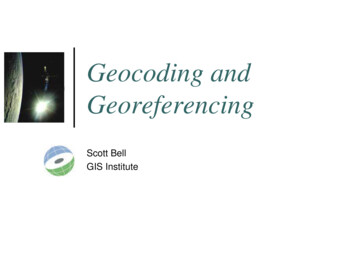
Transcription
TopicBetter LivingSubtopicArts & LeisureMasters ofPhotographyCourse GuidebookLearn Photography from 12 National Geographic MastersWilliam Albert Allard, Stephen Alvarez, Ira Block, Jodi Cobb, Annie Griffiths,Ed Kashi, Michael Melford, Cory Richards, Jim Richardson, Joel Sartore,Steve Winter, and Michael Yamashita
PUBLISHED BY:THE GREAT COURSESCorporate Headquarters4840 Westfields Boulevard, Suite 500Chantilly, Virginia 20151-2299Phone: 1-800-832-2412Fax: 703-378-3819www.thegreatcourses.comCopyright The Teaching Company, 2014Printed in the United States of AmericaThis book is in copyright. All rights reserved.Without limiting the rights under copyright reserved above,no part of this publication may be reproduced, stored inor introduced into a retrieval system, or transmitted,in any form, or by any means(electronic, mechanical, photocopying, recording, or otherwise),without the prior written permission ofThe Teaching Company.
National Geographic PhotographersPhotographer portaits: National Geographic Creative.William Albert AllardA major force at National Geographic and in mainstream photography for50 years, William Albert Allard has contributed to the Society’s magazinestories and books as a photographer and writersince 1964. He studied at the Minneapolis Schoolof Fine Arts (now the Minneapolis College of Artand Design) and the University of Minnesota. Mr.Allard is the author of six highly acclaimed books,including the award-winning Vanishing Breed:Photographs of the Cowboy and the West. Hislatest book, William Albert Allard: Five Decades, aretrospective and memoir, explores his long careerin both words and pictures. Among his worldwideexhibitions, his one-man show at the Tehran0XVHXP RI &RQWHPSRUDU\ UW LQ ZDV WKH ¿UVW exhibit of work by an American artist in Iran since1979. Considered one of color photography’s most celebrated pioneers, Mr.Allard is a former contributor to Magnum Photos, and his prints appear inprivate and museum collections. Learn more about his work online at http://ZZZ ZLOOLDPDOEHUWDOODUG FRP Ŷ Stephen Alvarez3KRWRJUDSKHU DQG ¿OPPDNHU 6WHSKHQ OYDUH] produces global stories about exploration,adventure, and culture. He has been a NationalGeographic magazine photographer since 1995and has published more than a dozen storieswith the magazine. Mr. Alvarez has won awardsfrom Pictures of the Year International andCommunication Arts. His story on the Maya andtheir religious rituals was exhibited at Visa pourL’Image, a renowned international photojournalismi
festival in Perpignan, France. Mr. Alvarez also has produced stories withNPR, including a story on underground Paris that won a 2012 White HouseNews Photographers Association award. He has appeared on NPR, PBS, andCBS News Sunday Morning and at the Annenberg Space for Photography, theShakerag Workshops, National Geographic Live, the Atlanta PhotojournalismSeminar, and the Banff Centre. Mr. Alvarez is a founding member of, andsocial media strategist for, The Photo Society, a group of contributingphotographers for National Geographic magazine. His work is on the web atKWWS DOYDUH]SKRWRJUDSK\ FRP ŶIra Block,UD %ORFN LV DQ LQWHUQDWLRQDOO\ DFFODLPHG SKRWRMRXUQDOLVW ¿OPPDNHU WHDFKHU and workshop leader who has produced more than 30 stories for NationalGeographic, National Geographic Traveler, andNational Geographic Adventure magazines. Hebegan his career as a newspaper photographer,earning numerous press club awards. His momentouscoffee-table book, Saving America’s Treasures,was a collaborative effort among the Clinton WhiteHouse, the National Geographic Society, and theNational Trust for Historic Preservation. Mr. Block’sphotographic exhibit Faces of Hope, portraits ofsurvivors and images of objects retrieved fromthe aftermath of the World Trade Center tragedy,is part of the permanent collection of the NationalSeptember 11 Memorial and Museum. As an expertin lighting, Mr. Block is sought after for assignments ranging from shootingancient artifacts in Greece to photographing dinosaur fossils in the Gobi Desertand documenting Moche mummies in Peru. View more of Mr. Block’s work atKWWS ZZZ LUDEORFN FRP Ŷ Jodi CobbJodi Cobb’s groundbreaking career spans more than three decades as astaff photographer with National Geographic, one of only four women tohave held that position in the magazine’s history. She has worked in morethan 65 countries, documenting closed societies and disappearing culturalii
traditions. Ms. Cobb is perhaps best known as the¿UVW SKRWRJUDSKHU WR GRFXPHQW WKH VHFUHW OLYHV and rituals of the geisha, revealed in her bookGeisha: The Life, the Voices, the Art. The bookwas nominated for the Pulitzer Prize and wonthe American Society of Media Photographers2XWVWDQGLQJ FKLHYHPHQW ZDUG ,Q DQRWKHU ¿UVW 0V &REE SURYLGHG DQ XQÀLQFKLQJ ORRN DW WKH EUXWDO UHDOLW\ RI KXPDQ WUDI¿FNLQJ LQ WKH NationalGeographic story “21st-Century Slaves.” Featuredas one of National Geographic’s Women of Visionin a new book and exhibition, Ms. Cobb hasrepeatedly received National Press Photographers Association Pictures of theYear and World Press awards. In 2012, she was awarded one of journalism’smost prestigious honors, the Missouri Honor Medal for Distinguished ServiceLQ -RXUQDOLVP /HDUQ PRUH DERXW 0V &REE DW KWWS ZZZ MRGLFREE FRP Ŷ QQLH *ULI¿WKV QQLH *ULI¿WKV KDV SKRWRJUDSKHG LQ QHDUO\ FRXQWULHV GXULQJ KHU illustrious career and worked on dozens of magazine and book projects forNational Geographic. Her books include A Camera, Two Kids, and a Camel:My Journey in Photographs, a memoir aboutbalance and the joy of creating a meaningful life, andNational Geographic Simply Beautiful Photographs,which was named the top photo/art book of 2011by both Amazon and Barnes & Noble. In additionWR KHU PDJD]LQH ZRUN 0V *ULI¿WKV LV WKH ([HFXWLYH 'LUHFWRU RI 5LSSOH (IIHFW ,PDJHV D FROOHFWLYH of photographers who document programs thatempower women and girls in the developing world,especially as they deal with the devastating effects ofclimate change. Known for her warmth and humorDV D OHFWXUHU 0V *ULI¿WKV KDV WKH LQQDWH DELOLW\ WR share stories from her photographs that bring to lifeboth the people and the cultures she documents. Learn more about her work atKWWS ZZZ DQQLHJULI¿WKV FRP DERXW Ŷiii
Ed Kashi(G .DVKL LV D SKRWRMRXUQDOLVW D ¿OPPDNHU DQG DQ HGXFDWRU GHGLFDWHG WR GRFXPHQWLQJ WKH VRFLDO DQG SROLWLFDO LVVXHV WKDW GH¿QH RXU WLPHV 6LQFH he has pioneered the movement to multimediaDQG ¿OPPDNLQJ LQ SKRWRMRXUQDOLVP SURGXFLQJ DQ LQQRYDWLYH ÀLS ERRN HQWLWOHG Iraqi KurdistanDQG DZDUG ZLQQLQJ VKRUW ¿OPV DQG PXOWLPHGLD projects on geopolitics and social issues. Mr. Kashihas won numerous awards from World PressPhoto and Pictures of the Year International, asZHOO DV WKH 81,&() 3KRWR RI WKH HDU IRU D Prix Pictet commission in 2010, and honors fromCommunication Arts and American Photo. He haspublished seven books, including Curse of the BlackGold: 50 Years of Oil in the Niger Delta and THREE.His latest book, Photojournalisms, is a compilationof journal writings to his wife, done over a nearly20-year period from various locations around the world. View more of Mr.DVKL¶V ZRUN DW KWWS HGNDVKL FRP EORJ ŶMichael MelfordMichael Melford is an internationally recognized photographer whohas worked with National Geographic for more than 30 years. He hasproduced 19 feature stories for National Geographic magazine and morethan 30 stories for National Geographic Traveler. His work also has beenfeatured on the covers of Newsweek, TIME,LIFE, Fortune, Smithsonian, GEO, Travel Leisure, Travel Holiday, and Coastal Living. Mr.Melford has won recognition from World PressPhoto, the International Center of Photography,the Art Director’s Club, and numerous otherarts organizations and publications. He alsohas produced photography for eight NationalGeographic books, including National GeographicTreasures of Alaska: The Last Great AmericanWilderness and Hidden Alaska: Bristol Bay andiv
Beyond. Mr. Melford teaches photography primarily through NationalGeographic; he leads one-day seminars around the country through NationalGeographic Traveler’s photo seminar series and travels with National*HRJUDSKLF ([SHGLWLRQV DERDUG WKH VPDOO VKLS ÀHHW DQG RQ RWKHU WULSV DURXQG WKH ZRUOG /HDUQ PRUH DERXW KLV ZRUN DW KWWS ZZZ PLFKDHOPHOIRUG FRP ŶCory RichardsA climber and visual storyteller, Cory Richards was named NationalGeographic Adventurer of the Year in 2012, the same year the AmericanAlpine Club presented him with its RowellAward. At the 2014 National Geographic([SORUHUV 6\PSRVLXP 0U 5LFKDUGV ZDV QDPHG to the inaugural group of National GeographicPhotography Fellows, whose work combinesvisual storytelling and exploration. Mr. Richards’scamera has taken him from the runway to the wildand remote corners of the world, from Antarctica’sunclimbed peaks to the Himalayas of Nepal andPakistan, in an attempt to capture not only thesoul of exploration but also the beauty of modernsociety. He is a passionate mountain climber onThe North Face athletic team and has carved aniche as one of the world’s leading adventureand expedition photographers. His photography has appeared in NationalGeographic magazine, Outside, and The New York Times LV ¿OP ZRUN KDV ZRQ DZDUGV DW QHDUO\ HYHU\ PDMRU DGYHQWXUH ¿OP IHVWLYDO LQFOXGLQJ JUDQG prize at the Banff Mountain Film and Book Festival for Cold. View more of0U 5LFKDUGV¶V ZRUN DW KWWS ZZZ FRU\ULFKDUGV FRP Ŷ Jim RichardsonJim Richardson has been a photographer for National Geographic formore than 30 years, specializing in global environmental issues andlandscapes. He also is interested in the Celtic world, with special attentionto Scotland and its remote islands. His documentary photography hasfocused on the American Great Plains and includes extended coverageof small-town life in his native Kansas. He has a 30-year photographicv
Joel SartoreJoel Sartore is a photographer and National Geographic Fellow, a speaker, awriter, a teacher, and a regular contributor to National Geographic magazine.His work has been recognized by the NationalPress Photographers Association and Pictures ofthe Year International. In addition to his work forNational Geographic, Mr. Sartore has contributedto Audubon magazine, TIME, LIFE, Newsweek,Sports Illustrated, and numerous book projects. Healso has published several books himself, includingRARE: Portraits of America’s EndangeredSpecies; Nebraska: Under a Big Red Sky; andPhotographing Your Family: And All the Kids andFriends and Animals Who Wander through Too.His most recent book is titled Let’s Be Reasonable.Mr. Sartore and his work have been the subjectsof several national broadcasts, including NationalGeographic Explorer, NBC Nightly News, NPR’s Weekend Edition, and anhour-long PBS documentary titled At Close Range with National Geographic.He is also a regular contributor on the CBS News Sunday Morning show. HisZRUN LV RQ WKH ZHE DW KWWS ZZZ MRHOVDUWRUH FRP Ŷ vi Jeff Mauritzen - inPhotograph.com.relationship with the people of Cuba, Kansas(population 220). This unusual body of work hasbeen excerpted in National Geographic, LIFE,and many other publications worldwide. Amonghis books is The Colorado: A River at Risk, whichhas been recognized widely for its contributionto awareness of water issues in the AmericanWest. In addition to photographing for NationalGeographic magazine, Mr. Richardson representsNational Geographic in keynote presentations,media appearances, cultural enrichment lecturesfor travel groups, and workshops. To view hisSRUWIROLR YLVLW KWWS ZZZ MLPULFKDUGVRQSKRWRJUDSK\ FRP Ŷ
Steve WinterSteve Winter has been a photojournalist withNational Geographic for more than 20 years,specializing in wildlife, particularly big cats. Heis also an adventurer who has been attacked byrhinos, stalked by jaguars, and charged by an 11foot grizzly bear. Mr. Winter was named WildlifePhotographer of the Year in 2008 and WildlifePhotojournalist of the Year in 2012 in a competitioncosponsored by the Natural History Museum inLondon and BBC Worldwide. He won the Picturesof the Year International Global Vision Award in DQG DQG UHFHLYHG ¿UVW SUL]H LQ WKH QDWXUH FDWHJRU\ IURP :RUOG Press Photo in 2008 and 2014. Mr. Winter is the coauthor of Tigers Forever:Saving the World’s Most Endangered Big Cat. He lectures globally onphotography and conservation issues and has been featured on NPR, aswell as the CBS Evening News, 60 Minutes, and other programs. Mr. Winterteaches workshops with Wildlife Photo Masterclass, a cooperative formedby National Geographic photographers. He is on the web at http://www.VWHYHZLQWHUSKRWR FRP ŶMichael YamashitaMichael Yamashita is a 30-year awardwinning veteran of National Geographic and hasphotographed a vast range of topics and locations,most notably in Asia. He has traipsed withcamels across the Taklimakan Desert, scaled peaksin Tibet, and journeyed the length of the GreatWall. He has published more than 30 NationalGeographic magazine features, as well as 10ERRNV H DOVR KDV WZR GRFXPHQWDU\ ¿OPV WR KLV credit, Marco Polo: The China Mystery Revealedand Treasure Fleet: The Adventures of Zheng He.His most recent book, Shangri-La: Along the Tea Road to Lhasa, took himto the far reaches of western China and the Himalayas to capture the fastdisappearing ancient culture of Tibet. Mr. Yamashita has taught at majorvii
photo workshops and art centers, including the Maine Media Workshops,Santa Fe Photographic Workshops, Tuscany Photo Workshop, and PalmBeach Photographic Centre. He also has conducted hands-on workshops inVXFK IDU ÀXQJ ORFDOHV DV 0\DQPDU &DPERGLD 7KDLODQG 6LQJDSRUH 7DLZDQ DQG &KLQD LV ZRUN LV RQOLQH DW KWWS ZZZ PLFKDHO\DPDVKLWD FRP Ŷviii
Table of ContentsINTRODUCTIONNational Geographic Photographers .iCourse Scope .1LESSON GUIDESADVENTURECory Richards and Stephen AlvarezLESSONS 1–2 .35HGH¿QH GYHQWXUH 5LFKDUGV%URDGHQ RXU 9LHZ 5LFKDUGVLESSONS 3–4 .176KRZ :KDW 1R 2QH DV 6KRZQ OYDUH]6HW WKH 6FHQH *HW &ORVH OYDUH]WILDLIFESteve Winter and Joel SartoreLESSONS 5–6 .318QGHUVWDQG WKH QLPDO :LQWHU8VH OO WKH 7RROV :LQWHULESSONS 7–8 .460DNH D 'LIIHUHQFH 6DUWRUH*R %DFN *HW ,W 5LJKW 6DUWRUHLANDSCAPE AND NATUREJim Richardson and Michael YamashitaLESSONS 9–10 .607KH -R\V RI 1DWXUH 5LFKDUGVRQ([SORULQJ /DQGVFDSHV 5LFKDUGVRQix
Table of ContentsLESSONS 11–12.75*XLGH WKH (\H DPDVKLWD0RPHQW LQ /DQGVFDSH DPDVKLWDPEOPLE IN THEIR ENVIRONMENTSJodi Cobb and Ira BlockLESSONS 13–14 .88*DLQLQJ 7UXVW &REE8QFRYHU WKH XPDQ &RQGLWLRQ &REELESSONS 15–16 .103%XLOG 5HODWLRQVKLSV %ORFN8VH WKH %DFNJURXQG %ORFNCOLOR AND LIGHT0LFKDHO 0HOIRUG DQG QQLH *ULI¿WKVLESSONS 17–18 .116*RRG %DG DQG 0DJLF /LJKW 0HOIRUG:DLW DQG :RUN WKH 6KRW 0HOIRUGLESSONS 19–20 .130&RPSRVH ZLWK &RORU *ULI¿WKV:ULWH ZLWK /LJKW *ULI¿WKVSTORYTELLINGWilliam Albert Allard and Ed KashiLESSONS 21–22 .145 HDUV RI 7HOOLQJ 6WRULHV OODUG0RPHQW *HVWXUH 3ODFH OODUGLESSONS 23–24 .158(QJDJLQJ WKH :RUOG .DVKL5DLVLQJ ZDUHQHVV .DVKLx
Table of ContentsSUPPLEMENTAL MATERIAL%LEOLRJUDSK\ .171xi
xii
National Geographic Masters of PhotographyScope:This course brings you the work of 12 National Geographicphotographers divided into six units: Adventure, Wildlife, LandscapeDQG 1DWXUH 3HRSOH LQ 7KHLU (QYLURQPHQWV &RORU DQG /LJKW and Storytelling. In each unit, you’ll hear from two world-renownedphotographers about their specialties and gain insight into the creativeprocess behind some of their iconic photographs.7KH ¿UVW XQLW GYHQWXUH LV WDXJKW E\ &RU\ 5LFKDUGV DQ H[SHULHQFHG mountain climber, and Stephen Alvarez, an adventurer who explores caves.In their lessons, you’ll learn how to tell the story of an expedition, includingthe importance of setting the scene and showing the human side of theDGYHQWXUH RX¶OO DOVR ¿QG WLSV RQ FRPSRVLWLRQ DQG OLJKWLQJ LQ WKH ¿HOG DQG VKRRWLQJ LQ GLI¿FXOW VSRWV WKDW \RX FDQ DSSO\ WR \RXU RZQ DGYHQWXUHV FORVHU to home. The next unit is Wildlife, taught by Steve Winter and Joel Sartore.Both of these photographers are interested in photographing animals in orderto save them and to encourage responsible stewardship of the natural world.Mr. Winter shares ideas for applying the techniques of wildlife photographyWR DQLPDOV \RX PLJKW ¿QG LQ \RXU RZQ EDFN\DUG ZKLOH 0U 6DUWRUH VXJJHVWV a number of interesting locations where you can interact with and photographexotic species. In the third unit, Landscape and Nature, Jim Richardson andMichael Yamashita show you how to capture the unexpected in landscapes.Mr. Richardson emphasizes the importance of adding new skills to yourSKRWRJUDSKLF UHSHUWRLUH²HYHQ LI LW PHDQV H[SHULPHQWLQJ ZLWK D ÀDVKOLJKW LQ the middle of the night. Mr. Yamashita discusses the relationship of designin general to photography, highlighting the shared concerns of landscapedesigners and photographers: layering, color, light, and impact on the viewer.7KH IRXUWK XQLW 3HRSOH LQ 7KHLU (QYLURQPHQWV LV WDXJKW E\ -RGL &REE DQG Ira Block. From these photographers, you’ll learn about gaining access to,and building relationships with your subjects. Ms. Cobb takes you insideVWRULHV VKH KDV VKRW LQ &KLQD ZKHQ LW ¿UVW UHRSHQHG WR WKH :HVW RQ D WRXU of the secret world of the geisha, and into heartbreaking scenes of human1
ScopeWUDI¿FNLQJ 0U %ORFN VKRZV \RX KRZ WR FDSWXUH WKH HQYLURQPHQW DQG activities of people you’re photographing and how to include the element ofVXUSULVH LQ \RXU LPDJHV ,Q WKH ¿IWK XQLW &RORU DQG /LJKW \RX¶OO KHDU IURP 0LFKDHO 0HOIRUG DQG QQLH *ULI¿WKV 0U 0HOIRUG GLVFXVVHV WKH IRXU W\SHV of light that photographers look for—diffuse light, side light, backlight,DQG PDJLF OLJKW²ZKLOH 0V *ULI¿WKV IRFXVHV RQ WKH SHUVRQDOLWLHV RI FRORUV and suggests numerous experiments you can try with color. Finally, the6WRU\WHOOLQJ XQLW WDXJKW E\ :LOOLDP OEHUW OODUG DQG (G .DVKL EULQJV together all the lessons of the course to show how you can put togetherphoto essays to document your travels, your neighborhood, or your dailylife. Mr. Allard discusses the importance of conveying a sense of placeand intimacy with your subjects in your photographs and provides tips onincorporating portraits into your stories and using available light. You’llalso be challenged with a range of assignments to apply these secrets toyour own photography. Ŷ2
Cory Richards—AdventureLessons 1–2All adventure is created through the people who engage in it, andfor this reason, an adventure encompasses much more than justthe challenges those people take on. It includes the people whoprovide support, the local culture, the action itself, and the vulnerability andhumanness of the adventurers. As photographers, we have to engage withall aspects of adventure. The more we can achieve that goal, the deeper andmore relatable our stories will be.Elements of Adventure PhotographyAdventure is often about being outside and taking on physical challenges,but there’s much more to it than that. It’s about relatable human moments—those times when the people on an expedition are carrying their gear in astorm or taking shelter inside a tent. It’s also about relationships—teammembers playing a board game or one team member learning from another.In adventure photography, you want to give viewers a sense of wonder andIHDU EXW \RX DOVR ZDQW WR ¿QG HOHPHQWV WKDW HYHU\RQH FDQ UHODWH WR 7U\ WR give your viewers something to hold onto.'LVFRPIRUW LV D VLJQL¿FDQW SDUW RI DQ\ DGYHQWXUH ,Q IDFW LI LW¶V QRW uncomfortable, it’s probably not a very challenging adventure. But thosetimes when you just want to curl up in the tent are exactly when you shouldtake out your camera and start shooting; such moments of exhaustion anddiscomfort are very relatable experiences.As an experiment, try taking portraits of the adventurers or their supportWHDP 7KLQN DERXW KRZ \RX FDQ UHSOLFDWH VWXGLR FRQGLWLRQV LQ WKH ¿HOG 7U\ WR make those images tell part of the story without showing the adventure itself.Look for a sense of immediacy in the scenes you photograph. Think ofPRPHQWV ZKHQ WKHUH LV D JUHDW GHDO RI DFWLYLW\ RU WKH ZHDWKHU LV ¿HUFH DQG try to capture that urgency. How can you show what it feels like to confront aGLI¿FXOW RU GDQJHURXV FKDOOHQJH"3
Strange or unexpected scenes or discoveries are sometimes present inadventure photography. Such moments draw viewers into your photographs,grabbing their attention and prompting them to wonder what’s going on inthe image.Lessons 1–2: Cory Richards—AdventureOne way to think about telling the story of an adventure as a whole is toask yourself a series of questions: First, how can you encapsulate the themeRI \RXU VWRU\ LQ DQ RSHQLQJ LPDJH" RZ FDQ \RX FRPELQH WKH VWRU\ RI WKH adventure itself with the local culture or other aspects of the surroundingHQYLURQPHQW \RX ZDQW WR KLJKOLJKW" 7KHQ KRZ FDQ \RX EULQJ YLHZHUV LQ HYHQ FORVHU" RZ FDQ \RX FDSWXUH D PRPHQW RI GLVFRYHU\ LQ DQ DGYHQWXUH VWRU\ RU EULQJ YLHZHUV LQWR WKH DFWLRQ" 1H[W ZKDW LV WKH SD\RII WR \RXU VWRU\" :KDW ZDV WKH XOWLPDWH JRDO RI WKH DGYHQWXUH" QG ¿QDOO\ KRZ FDQ \RX FORVH WKH VWRU\ ZLWK VRPHWKLQJ SRZHUIXO" &DQ \RX JLYH WKH YLHZHU RQH ODVW ORRN DW WKH EHDXW\ DQG PDMHVW\ RI WKH ODQGVFDSH" QVZHULQJ WKHVH TXHVWLRQV incorporates many of the basic skills and concepts of photography, such ascreative use of composition and light.Focusing on the LandscapeIn addition to the human element, to tell the story of an adventure, youalso need to show the landscape. After all, adventure photography is aboutincorporating the environment into the picture so that viewers start tounderstand what it feels like to be there. Try putting small people in largelandscapes to give viewers a sense of awe, or experiment with isolating oneperson in the landscape to show hardship. You can also isolate a person byusing color in a monochromatic landscape.Sometimes, you can put people in a landscape by using silhouette. ThisFDQ EH DQ HIIHFWLYH ZD\ WR VKRZ KRZ VPDOO DQG LQVLJQL¿FDQW KXPDQV DUH Silhouette also creates intimate moments—not with the human subjects butwith the landscape itself. This technique focuses viewers’ attention on thelandscape, giving them a sense of awe and wonder.View the landscape in terms of form. How can you use lines and color tocreate unexpected moments that are both engaging to the eye and move yourVWRU\ DORQJ" /RRN IRU ODQGVFDSHV WKDW DUH HLWKHU YHU\ VLPSOH RU YHU\ FRPSOH[ 4
Use large, open spaces—negative spaces—to isolate a single person andshow how intimidating the experience of an adventure can be.Composition and Lighting in the FieldLook for leading lines to help compose your frames. This can be a rope oreven a ray of light. The idea here is to draw the viewer’s eye to where youwant it to be. Be aware of forms and the interplay between forms to addgraphic impact to your images.Use composition to tell stories that are not necessarily immediatelyapparent. In a story about climbing, show the equipment and the clothing ofthe climbers. Focus on textures in the landscape or the human environment.Show the gritty details of the expedition, such as a dirty, exhausted climber.These elements help tell the story of climbing without showing theaction itself.Try to use natural light as much as you can, rather than distracting viewersZLWK RYHUW DGGHG OLJKWLQJ /RRN IRU XQXVXDO OLJKW VRXUFHV VXFK DV ¿UHV RX might also try experimenting with darkness in your images: Isolate a subjectin light and keep most of the rest of the frame dark. This technique oftengives a sense of vastness to an image.Remember that with a truly great and honest moment, composition,sharpness, and other elements of good photography come second. Suchmoments will never happen again, and you have to try to anticipate them.7KDW DQWLFLSDWLRQ LV D VLJQL¿FDQW SDUW RI ZRUNLQJ LQ D G\QDPLF DFWLYH environment. Always be aware of the light and the activity around you.Observing without Being PresentAs much as photography is about capturing the moment—just 1/500 of aVHFRQG²LW¶V DOVR DERXW WKH ¿YH GD\V EHIRUH WKH PRPHQW WKDW \RX VSHQG building relationships with your subjects. You want your subjects to feelcomfortable enough with your presence to ignore both you and the camera.That level of comfort comes about only by taking the time to get to know thepeople you’re photographing and by respecting their lifestyles and values.5
In most cases, photographers need to be observers who are not present.Unless you’re making a portrait, you don’t want subjects to make eye contactwith you. Remove yourself from the activity around you as much as you can.Communicating Larger IssuesPhotography is a powerful means of communicating information to help solvelarger problems. For example, photographs can relate the story of a changingculture, such as the sea gypsy people—the Bajau of Indonesia—or publicizethe dangerous effects of climate change on animal populations. Again, suchstories call on multiple skills for photographers. How can you show wildlifein an impactful way—by isolating a single animal, showing large numbersRI DQLPDOV RU SKRWRJUDSKLQJ DQ DQLPDO LQ D FKDQJLQJ HQYLURQPHQW" RZ FDQ \RX LOOXVWUDWH WKH HIIHFWV RI JOREDO ZDUPLQJ RQ WKH ODQGVFDSH" :KDW details can you use to reveal the human impact on an environment withoutQHFHVVDULO\ VKRZLQJ KXPDQV" )LQDOO\ FDQ \RX HQG ZLWK KRSH" &DQ \RX JLYH viewers the sense that we have the capacity to solve these problems, even ifZH GRQ¶W KDYH DOO WKH DQVZHUV ULJKW QRZ" GYHQWXUH SKRWRJUDSK\²RU DQ\ kind of photography—is about bringing together all your tools and skills tocreate images with the power to move your viewers.Lessons 1–2: Cory Richards—AdventureAssignment1. Pick a skill set in photography that isn’t your best or most solid, such asSRUWUDLWV ODQGVFDSHV RU ZLOGOLIH 7KHQ JR RXW LQWR WKH ¿HOG DQG UH¿QH your skills. Push through your own boundaries to expand what you cando with photography.6
5HGH¿QH GYHQWXUHLesson 1All images in Lessons 1 and 2 Cory Richards.Hikers isolated in landscape, Antarctica.7
/HVVRQ 5HGH¿QH GYHQWXUHClimbers.Inside a tent, Antarctica.8
Human experience of adventure.Portrait of an adventurer.9
/HVVRQ 5HGH¿QH GYHQWXUHFlurry of activity, Antarctica.Tent in mountain landscape.10
Single climber.11
Broaden Your ViewLesson 2: Broaden Your ViewLesson 2Hikers isolated in landscape, Mustang (border of Nepal and Tibet).12
Dirty, exhausted climber, Mustang.Basket of human remains.13
Lesson 2: Broaden Your ViewGnarled hands.14
Children, Choser village.%DMDX ¿VKHUPHQ 15
Lesson 2: Broaden Your ViewBajau man and children.Abandoned building, Krenkel Station, Heiss Island.16
Stephen Alvarez—AdventureLessons 3–4As a photographer, you can cover any number of subjects, but whatgets many photographers excited is adventure. To go somewherethat’s never been seen and share that experience with a larger worldthrough photography is what many photographers truly love. You can thinkof adventure as anything that pushes you outside your comfort zone, such asWKH ¿UVW WLPH \RX WUDYHO WR 1HZ RUN &LW\ RU WKH ¿UVW WLPH \RX À\ LQ D SODQH (YHQ ZDONLQJ GRZQ WKH VWUHHW LQ EHDXWLIXO OLJKW FDQ EH DQ DGYHQWXUH LI \RX allow yourself to view the experience in that way.Types of AdventureOf course, adventure often requires physical exploration, such as climbing amountain or discovering a cave. These situations present the opportunity toshow people a world they may never have seen. In caves, for example, manytimes, the only way you can see what’s around you is to make a photographof it; otherwise, there’s not enough light to even see the space you’re in.As you take on more challenges, you’ll become better at both the physicalabilities needed for your particular brand of adventure and the knowledgeyou need as a photographer. Keep a list of places you’d like to explore thatwill enable you to broaden both skill sets.In addition to photographing an adventure or expedition as it happens, youcan also try to capture a historical expedition. In this case, you’ll need toconduct research to learn how the adventurers traveled, where they went,and what they discovered.5XQQLQJ ODUJH H[SHGLWLRQV LV GLI¿FXOW EHFDXVH WKH\ RIWHQ LQYROYH PDQ\ people. If you’re the leader of such an expedition, be compassionate andunderstanding and lead by example to help people get things done. Inadventure photography, much of the story is about the expedition itself. Besure to shoot the food and equipment you take along, as well as the story ofmoving it to the site of y
National Geographic. Her books include A Camera, Two Kids, and a Camel: My Journey in Photographs, a memoir about balance and the joy of creating a meaningful life, and National Geographic Simply Beautiful Photographs, which was named the top photo/art book of 2011










